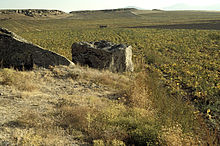Inscription stone from Suvasa
Coordinates: 38 ° 38 ′ 57.2 " N , 34 ° 17 ′ 23.1" E
The inscription stone of Suvasa in the Turkish countryside of Cappadocia contains an inscription in Luwian hieroglyphics from the 8th century BC. Chr.
location
The stone is located in a field about 1.5 kilometers southwest of the place Gökçetoprak (formerly Suvasa , also Sivasa) in the district of Gülşehir in the central Turkish province of Nevşehir , thus in the west of the historical landscape of Cappadocia. The flat terrain is broken here by individual flat volcanic rock ridges. One of them is south of the road leading to Ortaköy in the west, and the hieroglyphic stone lies in front of its western slope.
description
The trachyte block has a base area of 6.0 × 3.8 meters and is 4.2 meters high. It has the shape of a seat and seems to be in its original place. The theory that it might have rolled down from the hill in an earthquake is ruled out, since the characters that stand upright have no damage whatsoever. The two surfaces that correspond to the seat and the backrest are probably artificially cut, the other surfaces are of natural origin. Four depressions can be seen on the surface, the meaning of which is unclear. Ehringhaus rejects a function suggested by Rossner as bowls for libations and instead suggests that they could possibly have served to hold a statue in the middle and two smaller figures.
All sides except the back facing roughly east are inscribed with hieroglyphics. They are divided into four sections: A denotes the inscription pointing south, which is the only one that is only scratched and difficult to read, B is the inscription on the surface of the backrest facing west, C and A are two writing sections pointing towards the northwest and towards the north Side faces pointing north-northwest. All inscriptions are to be read counter-clockwise, with the exception of inscription D, which is written bustrophedon . The following translations are made by Frank Starke for Horst Ehringhaus ' volume on the Luwian rock reliefs in Asia Minor:
- Inscription A only contains an incompletely preserved place name.
- Inscription B: Sarija, priest of Sarruma , the superior king, great cupbearer in the presence of Wasusarma, the great king, the hero
- Inscription C:… tawa, Tata's son, graciously distinguished servant of Wasusarma, the man endowed with government,… and great king
- Inscription D: Kuwala (na) zidi… Great one of the hundred…
Wasusarma was the last Luwian ruler of the Kingdom of Tabal , he ruled from 738 to 730/29 BC. In the inscription, three of his servants introduce themselves with titles and their relationship to the great king. In Tabal, its tradition was upheld to a greater extent than in the other successor states of the Hittite Empire. This is expressed, for example, in the use of the title Great King , as well as in the name Great, a title for court officials that was already used in Hittite texts from the 16th to 13th centuries BC. Appears. The greats formed a constitutional body in the great empire, which in other late Hittite empires of the 1st millennium BC. No longer exists. The traditional alignment of tabal is also indicated by the use of archaic, very rare syllable or word characters in the texts. These include, for example, the bird and the fish in inscription C, which are hardly or not at all known from other inscriptions. The same applies to the rock inscription of Topada about 25 kilometers to the southeast , the author of which is the Wasusarma mentioned here. The stele of Kayseri and that of Sultanhanı were also made by subjects of Wasusarma.
A settlement near the stone is not known, there is also no drinking water in the vicinity. In the course of excavations, which have been taking place on a settlement mound six kilometers to the southwest since 2007, numerous fragments came to light in the nearby village of Ovaören, on which the name Wasusarmas is also mentioned in Luwian hieroglyphs.
Research history
The inscription was discovered in November 1906 by the German archaeologist and art historian Hans Rott and published in 1908 by Leopold Messerschmidt . In 1934 Bedřich Hrozný , the decipherer of the Hittite language , visited the place. He interpreted the stone as an altar and exposed some previously undiscovered lines of writing. The ancient orientalist Ignace Gelb took photographs of the stone in 1935. In 1989 the Hittite scientist John David Hawkins researched the inscription and published its translation in 2000 in his Corpus of Hieroglyphic Luwian Inscriptions.
literature
- Eberhard P. Rossner: Rock monuments in Turkey. Volume 1: The Hittite rock reliefs in Turkey. An archaeological guide. 2nd, expanded edition. Rossner, Munich 1988, ISBN 3-924390-02-9 , pp. 125-130.
- John David Hawkins : Corpus of Hieroglyphic Luwian Inscriptions Vol. 1: Inscriptions of the Iron Age. Part 1 (= Studies on Indo-European Linguistics and Cultural Studies NF 8, 1). de Gruyter, Berlin / New York 2000. ISBN 3-11-010864-X , pp. 462-463 No. X.13 ( Google book search ).
- Horst Ehringhaus : The end that was a beginning - rock reliefs and rock inscriptions of the Luwian states of Asia Minor from 12th to 8th/7. Century BC Chr. Nünnerich-Asmus, Mainz 2014, ISBN 978-3-943904-67-3 , pp. 40–47.
Web links
Individual evidence
- ^ John David Hawkins: Corpus of Hieroglyphic Luwian Inscriptions Vol. 1, 1 . de Gruyter, Berlin / New York, 2000, p. 462 ( limited preview in Google Book search).




